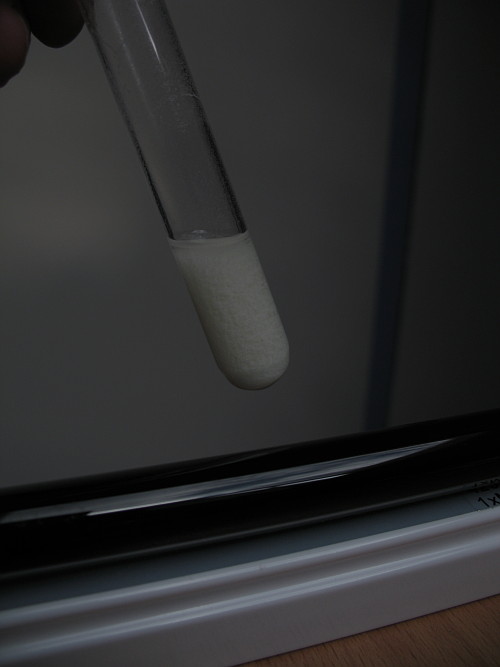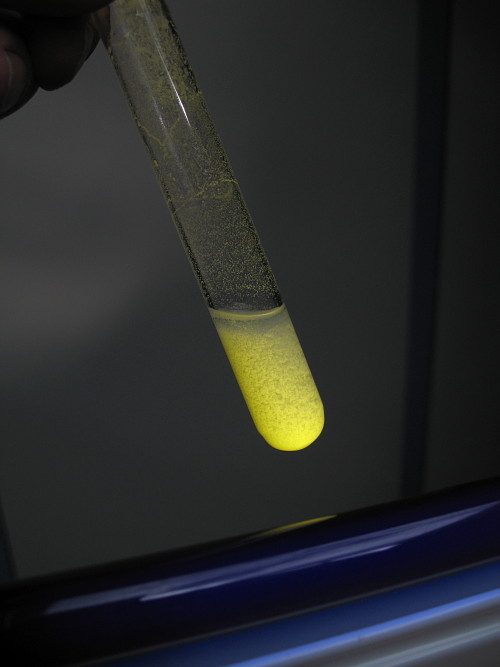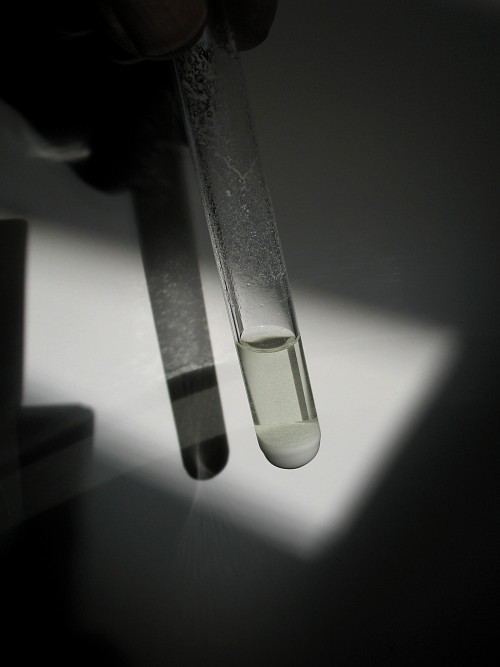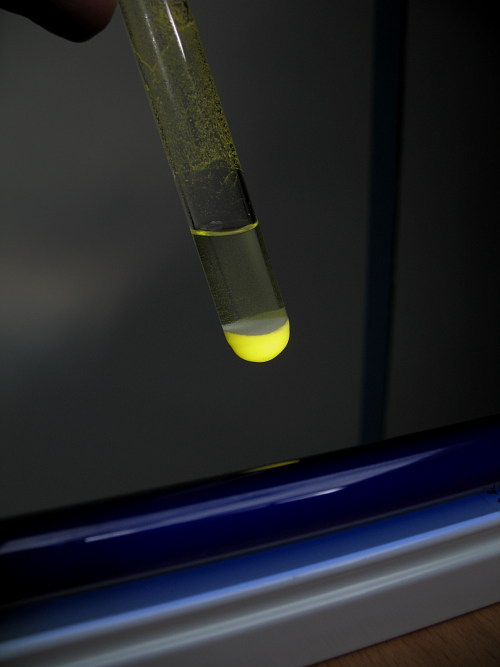| Pages:
1
2 |
woelen
Super Administrator
        
Posts: 8013
Registered: 20-8-2005
Location: Netherlands
Member Is Offline
Mood: interested
|
|
Yet even more copper chemistry...
Yes, the element copper is intriguing me again. This element has such a remarkably rich chemistry. This time I did some experimenting with copper
sulfate and potassium thiocyanate (the sodium salt and ammonium salt work equally well).
http://woelen.homescience.net/science/chem/exps/copper_thioc...
This webpage is far from exhaustive, even more different results can be obtained by simply mixing thiocyanate and copper(II). Other variations are
dependency on pH and the presence of other coordinating ions like chloride. The webpage is just a first step in a direction of research where lots of
things can be discovered, even for home chemists. Unfortunately, the amount of accessible literature on these (iso)thiocyanato complexes is very
limited.
|
|
|
Taoiseach
Hazard to Others
  
Posts: 241
Registered: 16-3-2008
Member Is Offline
Mood: No Mood
|
|
Very nice 
How stable is the black Cu(NCS)2?
Also I wonder if mixed species can be formed, like
[(Cu2+)(NCS-)]Cl-
Cl- might be a bad choice because it easily coordinates to the copper. ClO4- might work as it rarely every acts as a ligand.
|
|
|
Nerro
National Hazard
   
Posts: 596
Registered: 29-9-2004
Location: Netherlands
Member Is Offline
Mood: Whatever...
|
|
Are you sure the ligand complexes via the N rather than S? Are polymers formed?
#261501 +(11351)- [X]
the \"bishop\" came to our church today
he was a fucken impostor
never once moved diagonally
courtesy of bash
|
|
|
JohnWW
International Hazard
    
Posts: 2849
Registered: 27-7-2004
Location: New Zealand
Member Is Offline
Mood: No Mood
|
|
S usually bonds to transition metal cations preferentially to N or Cl- or O. That is why H2S is so poisonous, and also a catalyst poison. An exception
would be the most highly electropositive transition metals, i.e. the rare earth metals (group III-B) , and the group IV-B metals.
[Edited on 5-1-09 by JohnWW]
|
|
|
kmno4
International Hazard
    
Posts: 1497
Registered: 1-6-2005
Location: Silly, stupid country
Member Is Offline
Mood: No Mood
|
|
There is large amout of literature about Cu - SCN complexes and their structures.
For example:
Bonding properties of thiocyanate groups in copper(II) and copper(I) complexes.
(Coordination Chemistry Reviews,1995 )
An old (1916) article - The action of water on cupric thiocyanate (RSC, CT9160900597) - describes stoichiometry of decomposition of Cu(SCN)2 in H2O.
These are only two from hundred articles about Cu/SCN - - serching machines on chemical databases are for free.
BTW.
Cu(SCN)2 reminds me, similar in colour, K2Pb[Cu(NO2)6]*. Introducing Cu(II) to NaNO2 solution also gives green complex (but green colour = yellow+blue
ones  ). ).
* some books wrongly describe this salt as K2Cu[Pb(NO2)6].
X-ray investigations of crystal structure clearly show existence of Cu(NO2)6 (4-) anion, not Pb(NO2)6 (4-) .
[Edited on 6-1-2009 by kmno4]
|
|
|
kmno4
International Hazard
    
Posts: 1497
Registered: 1-6-2005
Location: Silly, stupid country
Member Is Offline
Mood: No Mood
|
|
Recently I have made few experiments with Cu(II) in acetone solutions. Starting materials were CuSO4 (anhyd.), KSCN and KBr etc.
Results are interesting:
with KSCN deep red-brown solution (stable) and adding a few drops of pyridine or morpholine gives light green solution.
KBr gives deep green solution and acetone is slowly converting to bromoacetone.
NaCl gives brown-yellow sol., Pb(NO3)2 gives (slowly) nice blue sol. (both experiments in progress).
All proportions was 1-1,5 g CuSO4 + 20 ml acetone+ stoichiometric amout (counting for Cu) of "countersalts".
Really interesting..... try it 
|
|
|
woelen
Super Administrator
        
Posts: 8013
Registered: 20-8-2005
Location: Netherlands
Member Is Offline
Mood: interested
|
|
If you have anhydrous CuCl2, then you can even make an "acetoned" solid salt.
Simply dissolve some CuCl2 in acetone and heat to 40 C or so. Try to dissolve as much of CuCl2 as possible. You get a very dark green/brown solution.
Decant the solution from any remaining solid and let the solution stand for one day. After a day, the solution has become much lighter. A copper-red
solid has settled at the bottom. The solid actually looks a little bit like metallic copper, except that it is slightly more yellow and if the
crystals are large, then it is slightly transparent as well.
This red/brown solid has formula CuCl2.xCH3COCH3. I do not know the value of x though.
A nice further experiment is to decant the liquid from the crystals and let them dry (which only takes a few minutes in luke-warm air). Next, heat the
crystals and light the vapor coming from the crystals. The vapor is acetone. The crystals become dark brown: free anhydrous CuCl2.
|
|
|
ChemSys
Harmless

Posts: 1
Registered: 23-4-2006
Member Is Offline
Mood: No Mood
|
|
You can try another experiment with CuSCN... 
Heat white dry CuSCN in a test tube. It produces CS2 vapors and some other substances. Carbon disulphide easily condenses into liquid state by
cooling. IMHO, it's a quite simple way to obtain 1-2 ml of impure CS2.
|
|
|
kmno4
International Hazard
    
Posts: 1497
Registered: 1-6-2005
Location: Silly, stupid country
Member Is Offline
Mood: No Mood
|
|
| Quote: | Originally posted by woelen
If you have anhydrous CuCl2, then you can even make an "acetoned" solid salt.
Simply dissolve some CuCl2 in acetone and heat to 40 C or so. Try to dissolve as much of CuCl2 as possible. You get a very dark green/brown solution.
Decant the solution from any remaining solid and let the solution stand for one day. After a day, the solution has become much lighter...
|
Sounds interesting. I do not have CuCl2 (even x H2O) but CuCl2 is generated from reaction CuSO4 and NaCl in acetone. I will repeat this with much
higher concentrations.
I will see if this method works at all....
ps. have you got any good reference about this reaction (procedure) ? I mean not just quotation from a book, but journal reference.
[Edited on 14-2-2009 by kmno4]
|
|
|
woelen
Super Administrator
        
Posts: 8013
Registered: 20-8-2005
Location: Netherlands
Member Is Offline
Mood: interested
|
|
I have no reference at all. I found out myself. The prep is very easy and you can also easily show that the red/brown stuff contains acetone (on
heating, it turns into anhydrous CuCl2 and you get a strong smell of acetone).
|
|
|
Jor
National Hazard
   
Posts: 950
Registered: 21-11-2007
Member Is Offline
Mood: No Mood
|
|
If you want some anhydrous CuCl2, do the following:
-prepare the dihydrate, for example by dissolving the oxide or basic carbonate in hydrochloric acid, and evaporating/crystallising.
-to the CuCl2.2H2O (With probably some mixed HCl in it, giving it the green color), add concentrated sulfuric acid or heat SLOWLY. This will get you
the anhydrous form in both methods. The former is problematic, because I'm not sure how to remove the sulfuric acid completely from the CuCl2, the
latter is problematic as you have to do it really slowly, or it will just hydrolyse forming a basic chloride and HCl. This therefore takes time.
|
|
|
panziandi
Hazard to Others
  
Posts: 490
Registered: 3-10-2006
Location: UK
Member Is Offline
Mood: Bored
|
|
Jor wouldn't your former method make copper sulphate and release hydrogen chloride? You could put the CuCl2.xH2O in a shallow dish OVER H2SO4 in a
dessicator, perhaps that would work particularly if its under vacuum and left for a while.
(could always use SOCl2 too... hehe  ) )
|
|
|
Jor
National Hazard
   
Posts: 950
Registered: 21-11-2007
Member Is Offline
Mood: No Mood
|
|
Thionyl chloride  ... ...
Im not sure if sulfuric will convert the CuCl2 to HCl and CuSO4. Are you sure? This happens with NaCl, but I remember that doing the experiment with
CuCl2.2H2O (I once made 1g of it, was not very pure, because I didn't know how to make it in early days  ), that a brown powder formed, with hardly any bubbling. It was about 15C. ), that a brown powder formed, with hardly any bubbling. It was about 15C.
|
|
|
Paddywhacker
Hazard to Others
  
Posts: 478
Registered: 28-2-2009
Member Is Offline
Mood: No Mood
|
|
More copper
Cupric tartrate is soluble in excess alkaline tartrate to give Fehling's Solution, but is Cupric Tartrate itself soluble in water? What about Cupric
Hydrogen Tartrate? What about the citrates?
Here is a photo of an experiment to answer those questions.
http://s265.photobucket.com/albums/ii236/Beryllium9/?action=...
|
|
|
woelen
Super Administrator
        
Posts: 8013
Registered: 20-8-2005
Location: Netherlands
Member Is Offline
Mood: interested
|
|
What is this white material? It looks as if a copper(I) compound is formed. Or is this white color an artefact of the photography?
|
|
|
Paddywhacker
Hazard to Others
  
Posts: 478
Registered: 28-2-2009
Member Is Offline
Mood: No Mood
|
|
| Quote: | Originally posted by woelen
What is this white material? It looks as if a copper(I) compound is formed. Or is this white color an artefact of the photography?
|
The mixtures were all initially black from the copper oxide, but reacted with the acids when the vials were heated in a pressure cooker for an hour.
The light coloured material is the product, and you can guess its solubility from both the amount of deposit and the blue colour of the water.
The copper tricitrate may have all reacted, and it may be that dark brown colour, or the colour might arise from unreacted copper oxide.
The colours are genuine. I don't think the copper was reduced to Cu(I), because the same-looking precipitates can be made by mixing solutions of
CuSO4 with solutions of tartrates or citrates.... but I could easily be mistaken.
[Edited on 2-3-2009 by Paddywhacker]
|
|
|
woelen
Super Administrator
        
Posts: 8013
Registered: 20-8-2005
Location: Netherlands
Member Is Offline
Mood: interested
|
|
Another explanation might be that anhydrous precipitates are formed, in which the copper-ions are not coordinated to water, but to citrate/tartrate.
But this does surprise me somewhat, because normally these coordination complexes are deep blue. It might also be that the precipitates simply are
from the acid itself, or some mix of the the acid and a copper tartrate/citrate.
It is interesting to know what happens when a lot of water is added to the precipitates. Do they dissolve and what color do you get?
|
|
|
woelen
Super Administrator
        
Posts: 8013
Registered: 20-8-2005
Location: Netherlands
Member Is Offline
Mood: interested
|
|
I tried the experiment with a large excess of citric acid and copper(II) oxide:
http://woelen.homescience.net/science/chem/exps/exppatt.cgi?...
The result of my experiment differs a lot from the one, reported by Paddywhacker. I end up with a nice green crystalline powder of cupric citrate,
somewhat resembling cupric acetate, but a little lighter and greener.
|
|
|
Paddywhacker
Hazard to Others
  
Posts: 478
Registered: 28-2-2009
Member Is Offline
Mood: No Mood
|
|
A photo would be nice to see the comparison. You found the CuO not so easy to dissolve. I solved that by capping the vials and heating them in a
pressure cooker for an hour... which was probably excessive.
That is one of the intreaguing things about these compounds.
It seems that with excess citrate, or excess tartrate, you get complexes that are different from the plain salt.
The experiments I setu up tried to get the molar ratios right to give me exactly Cu(H2Citrate)2, Cu(HCitrate), and Cu3(Citrate)2 ... and the
corresponding tartrate salts.
My idea had been to find a sparingly soluble copper salt and grow nice big blue crystals of it via the hydrothermal process, but I never set up the
gear.
[Edited on 7-3-2009 by Paddywhacker]
|
|
|
kmno4
International Hazard
    
Posts: 1497
Registered: 1-6-2005
Location: Silly, stupid country
Member Is Offline
Mood: No Mood
|
|
Just something nice - luminescence of Cu4I4Py4
Preparation is extremely simple* and effect is interesting: seledine luminescence of this complex under UV (BLB lamp).
When complex loses some pyridine in the air, it becomes completly odorless (in my case it is colored gray because some impurities) and luminescence
changes to yellow-orange.
Some pictures below (UV pictures are bad quality but I did not want to play with camera settings). Yellow-white powder is freshly prepared complex,
gray powder is dried for a few days in the air powder.
This complex can be recrystallized from DCM, acetone, acetonitrile... etc
Normal light

..and BLB lamp

* for example:
http://dx.doi.org/10.1021/ja00008a026
http://dx.doi.org/10.1021/ic061147f
see also attachment
[Edited on 11-9-2009 by kmno4]
Attachment: ppp.rar (619kB)
This file has been downloaded 730 times
|
|
|
Jor
National Hazard
   
Posts: 950
Registered: 21-11-2007
Member Is Offline
Mood: No Mood
|
|
Very nice kmno4! So the complex is quite unstable? Also if stored in a closed container, over pyridine vapour?
|
|
|
kmno4
International Hazard
    
Posts: 1497
Registered: 1-6-2005
Location: Silly, stupid country
Member Is Offline
Mood: No Mood
|
|
Quote: Originally posted by Jor  | | Very nice kmno4! So the complex is quite unstable? Also if stored in a closed container, over pyridine vapour? |
Rather stable, but stable form seems to be this with yellow luminescence.
Partial dried complex looks funny, with yellow-blue luminescence:

In a daylight it is practically white.
|
|
|
woelen
Super Administrator
        
Posts: 8013
Registered: 20-8-2005
Location: Netherlands
Member Is Offline
Mood: interested
|
|
Kmno4, this is a great find. Beautiful! Of course I could not resist trying it myself. I have all required chemicals.
I once made some CuI (a long time ago and I still have it). It is an off-white solid. I think pure CuI is white like snow, but mine is good enough for
most experiments.
I dissolved some KI in water and boiled for a while to get rid of dissolved oxygen. To this I added some CuI. Only part of it dissolves, I obtained a
pale yellow solution, almost colorless with an off-white precipitate at the bottom.
When this precipitate of CuI under a solution of KI/CuI is illuminated with a black light no special effect can be observed.
In another test tube, I took 3 ml of acetone and added four drops of pyridine (appr. 0.2 ml). The pyridine dissolves in the acetone without problem.
Next, I added this solution to the test tube, in which there is the solution of KI+CuI and solid CuI at the bottom. At first all material seems to
dissolve, but almost immediately, a white precipitate is formed. The pale yellow color becomes even paler, and what remains is a white and fairly
compact precipitate under a nearly colorless liquid.
This is a picture of the material in a dimly lit room.

In the picture you can see a black light tube. Next, I switched on the tube. It hardly gives off any visible light and the digital camera also makes
little of the UV-light. The solid material, however, beautifully lights up, showing yellow fluorescence.

|
|
|
woelen
Super Administrator
        
Posts: 8013
Registered: 20-8-2005
Location: Netherlands
Member Is Offline
Mood: interested
|
|
Here I have a few pictures of the same material, after the precipitate has settled at the bottom. First a picture in a beam of sunlight in the
otherwise dimly lit room and then the same precipitate placed somewhat above and behind the blacklight tube.
Here is the material in sunlight:

And this is near the blacklight:

|
|
|
kmno4
International Hazard
    
Posts: 1497
Registered: 1-6-2005
Location: Silly, stupid country
Member Is Offline
Mood: No Mood
|
|
Another complex Cu2I2, this time with morpholine.
In daylight this is white powder with weak green shade, odorless.
In UV it showes orange luminescence (on the picture).
These complexes were described long time ago. My fellow has sent me a picture of pyridine complex recently and interested me with this. Some time ago
I tried urotropine complex of CuCN but because of unknown (to me) reasons it did not show any luminescence (but should do).
Many amines can be used for preparations these nice things - have a nice experimenting 

|
|
|
| Pages:
1
2 |